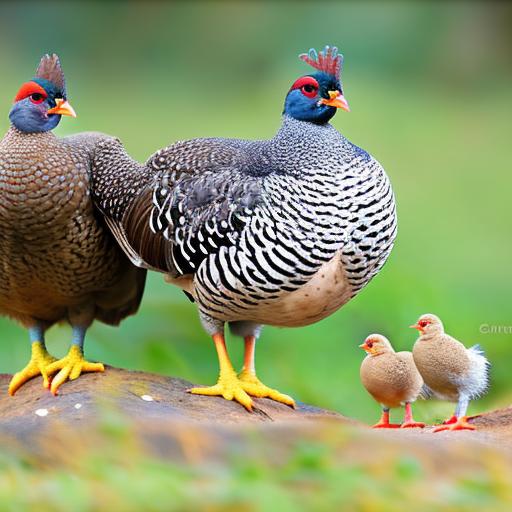Have you ever caught yourself daydreaming about turning your backyard into a peaceful haven where guinea fowl and chickens coexist in perfect harmony? If so, you’re not alone. The thought of these two bird varieties mingling under the same patch of sky has captured the imaginations of many poultry lovers and homesteaders alike.
Yet there’s often a nagging concern: will they truly get along, or will my days be filled with breaking up feathered tiffs?.
As someone who has walked this path with equal parts curiosity and caution, I’ve discovered that it is indeed possible for guinea fowl to live side by side with chickens. (A little-known fact: guinea fowls are like the neighborhood watch for your flock!) This article draws from my own hands-on experiences as well as expert advice to help you cultivate a peaceful environment where both species can thrive together.
Perhaps surprisingly, encouraging these different birds to share their space can be quite straightforward when armed with the right knowledge. From interpreting their quirky behaviors to designing an inviting habitat tailored just for them, I’m here to guide you through everything necessary for fostering tranquility in your coop.
Join me as we explore practical tips for serenely blending guinea fowl and chickens in your very own backyard—it might just be easier than you think!
Understanding Guinea Fowl and Chickens
Guinea fowl and chickens have different behaviors, social structures, and needs. It’s important to understand these differences in order to successfully integrate them into the same space.
Differences in behavior and needs
Understanding the differences in behavior and needs between guinea fowl and chickens is vital for successful cohabitation. As a keeper, it’s my duty to ensure both species can thrive together. Here’s a rundown of their unique characteristics:
| Behavior/Need | Guinea Fowl | Chickens |
|---|---|---|
| Social Structure | They are independent yet social, functioning well alone or in a flock. | Prefer a hierarchical social structure with a clear pecking order. |
| Territorial Behavior | Can be more territorial, especially during mating season. | Less territorial, although some breeds can show similar behaviors. |
| Aggressiveness | May engage in fights, requiring careful management of flock dynamics. | Usually less aggressive, but still need monitoring to manage pecking order issues. |
| Diet | Excellent insect killers, they also eat seeds and plants. | Consume a varied diet including grains, greens, and insects. |
| Roosting Habits | Prefer to roost in trees or high places for safety. | Typically roost on provided perches inside the coop. |
| Guarding Behavior | Act as natural watchdogs, alerting to dangers with loud calls. | Less vigilant, relying on keepers or guinea fowl for alerts. |
| Foraging Behavior | More extensive foragers, may wander farther from the coop. | Usually forage within a closer range of their home base. |
As I navigate the responsibility of keeping these birds, it’s clear that attention to their distinct behaviors and needs is the cornerstone of a peaceful and productive backyard flock.
Differences in social structure
Guinea fowl and chickens have distinct social structures. Guinea fowls are known for their strong flock mentality, often forming close-knit groups with clear hierarchies. They establish pecking orders within the flock to determine dominance and maintain order.
Chickens, on the other hand, also have a pecking order but tend to form larger, looser flocks with less rigid hierarchies compared to guinea fowl.
Guinea fowls generally prefer small group dynamics where they can establish strong social bonds. In contrast, chickens tend to be more adaptable in larger groups and may not form as tight-knit relationships as guinea fowl do within smaller formations.
Coexisting in the Same Space
To ensure a harmonious living arrangement, it’s important to provide separate areas for guinea fowl and chickens within the same space. Creating designated roosting and nesting areas for each species can help minimize any potential conflicts and promote peaceful coexistence between the two.
Additionally, encouraging socialization between guinea fowl and chickens through supervised interactions can help them get accustomed to each other’s presence.
Providing separate areas for each species
To ensure a harmonious coexistence between guinea fowl and chickens, it’s essential to provide separate areas for each species. This helps reduce competition and potential conflicts. Here are the key considerations when providing separate areas for guinea fowl and chickens:
- Design distinct housing structures for guinea fowl and chickens, ensuring each has its own space for roosting and nesting.
- Establish separate feeding stations to prevent food disputes and allow each species to consume their preferred diet without interruptions.
- Create designated dust bathing areas for both guinea fowl and chickens to indulge in their natural behavior without encroaching on each other’s territories.
- Install fencing or barriers to delineate specific zones within the shared outdoor space, giving each species defined areas for roaming and foraging.
- Implement visual barriers such as plants or structures to provide privacy for both guinea fowl and chickens, reducing stress and territorial conflicts.
Encouraging socialization between the two species
To ensure a harmonious coexistence between guinea fowl and chickens, it’s essential to encourage socialization between the two species. Here are some ways to do that:
- Introduce them at a young age, as this increases the likelihood of positive interactions as they grow.
- Provide ample space for both species to roam freely and explore each other’s territories.
- Offer treats like mealworms or scratch grains together, so they associate each other’s presence with pleasant experiences.
- Observe their interactions closely and intervene if any aggressive behavior arises.
- Create a calm environment by minimizing disturbances when they are getting to know each other.
- Incorporate environmental enrichment such as perches or hiding spots for both guinea fowl and chickens to share.
Feeding and Dietary Considerations
– Guinea fowl and chickens have different dietary needs and feeding habits, which can lead to potential competition for food. Managing their diets and providing separate feeding areas will be essential for a harmonious coexistence.
Differences in diets and feeding habits
Guinea fowl and chickens have different dietary needs; guineas thrive on a higher-protein diet, while chickens prefer grains and seeds. Guinea fowl need more animal-based protein, such as insects and worms, to maintain their health. Despite their differences, both species can eat the same commercial poultry feed when necessary.
When feeding guinea fowl and chickens together, it’s important to monitor for potential food competition. Providing separate feeding areas or using larger feeders can help ensure that each bird gets enough to eat without excessive competition or stress. By understanding their distinct dietary requirements, we can promote a peaceful coexistence between guinea fowl and chickens in our flock.
Potential competition for food
Now, let’s talk about potential competition for food between guinea fowl and chickens. Both species have different dietary needs and feeding habits. Guinea fowl are voracious insect eaters, while chickens focus on grains and seeds.
This difference can lead to some competition during mealtime as they might go after the same food sources in their shared environment.
To manage this, ensure there are separate feeding areas for both guinea fowl and chickens. Place feeders at different heights to cater to their natural behaviors – with lower ones for the ground-feeding chickens and higher placements for guinea fowl who prefer to roost before eating.
Managing the Pecking Order
I will discuss techniques for managing aggressiveness and dominance within the flock, as well as how to introduce new birds to the group. It’s important to create a harmonious environment for both guinea fowl and chickens to thrive together.
Techniques for managing aggressiveness and dominance
To manage aggressiveness and dominance between guinea fowl and chickens:
- Provide separate feeding areas to prevent competition.
- Offer multiple water sources to reduce conflict over this essential resource.
- Provide hiding spots or shelters for birds to escape aggressive individuals.
- Observe flock dynamics regularly to address any emerging dominance issues.
- Introduce new birds gradually to minimize stress and aggression.
- Monitor mating behavior, especially during guinea fowl mating season, to prevent conflicts.
Introducing new birds to the flock
When introducing new birds to the flock, it’s essential to consider the dynamics and behaviors of both guinea fowl and chickens. Here are some key steps to follow:
- Gradual Introduction: Introduce new birds gradually, allowing them to be within sight but not in direct contact with the existing flock.
- Providing Separate Space: Create a separate space within the coop or yard for the new birds to acclimate without being subjected to aggression from the established flock.
- Monitoring Interactions: Keep a close eye on interactions between the existing flock and the newcomers, ensuring that any aggressive behavior is minimized.
- Offering Distraction: Provide environmental enrichments such as perches, hiding spots, and food puzzles to divert attention and reduce potential conflict during introductions.
- Supervised Integration: Once initial interactions have been observed and tensions have eased, supervise direct interaction between the new birds and the existing flock.
- Patience and Observation: Allow time for the integration process while closely observing how the new birds assimilate into the existing social structure of both guinea fowl and chickens.
- Resolving Conflicts: If conflicts arise, be prepared to separate birds if necessary while still providing visual contact until they become familiar with each other.
- Balancing Flock Dynamics: Keep in mind that balance within the flock may take time to establish as pecking orders are redefined with the addition of new members.
- Regular Check-Ins: Continuously monitor interactions over several days or weeks to ensure that all birds are integrating peacefully into a cohesive group.
- Providing Safety Measures: Ensure that all birds have access to shelter, food, water, and safe spaces during their introduction period for their well-being.
Benefits of Raising Guinea Fowl with Chickens
– Natural pest control and foraging habits of guinea fowl can help keep the backyard free from insects, while chickens contribute to additional egg production. The coexistence of both species also provides increased protection and guarding in the backyard.
Natural pest control
Guinea fowl and chickens living together can provide effective natural pest control in your backyard. The guinea fowl are excellent at consuming ticks, spiders, and other small insects that may bother your chicken flock.
Their keen foraging instincts make them great partners for keeping the insect population under control within the shared environment which benefits both types of birds. As a guinea fowl keeper, it’s important to note that their foraging habits not only contribute to pest control but also aid in maintaining a healthy environment for the entire flock.
Moreover, with their alert nature, guinea fowls act as watchdogs by sounding alarms when potential threats or predators approach, offering an added layer of protection to your backyard birds.
By having both species cohabiting harmoniously, you can benefit from improved pest management through their combined efforts while enjoying enhanced security against intruders. Encouraging such cooperative behavior between guineas and chickens can lead to a well-balanced ecosystem in your domesticated farm set-up.
Additional egg production
Guinea fowl can significantly boost egg production in a mixed flock. Their eggs have a higher yolk-to-white ratio, offering a unique flavor and nutritional profile. Guinea hens typically lay more eggs each year compared to chickens, providing an additional source of fresh eggs for your household.
With their distinct taste, guinea fowl eggs can be highly sought after by discerning customers who value specialty or gourmet products.
Mixing guinea fowl with chickens can result in diverse egg colors within the same coop. Guinea hen eggs often have speckled or spotted shells, adding variety to your egg collection and enhancing aesthetic appeal.
Increased protection and guarding in the backyard
Guinea fowl are natural watchdogs, alerting the flock to potential threats. They can provide added security and protection for chickens in the backyard, making them an asset in safeguarding against predators.
Their vigilant nature and loud calls serve as a deterrent to potential intruders.
The presence of guinea fowl alongside chickens creates a more robust defense system for the entire flock. With their heightened awareness and keen sight, guinea fowl act as additional guardians, enhancing the overall safety and protection of the coop and surrounding area.
Conclusion
In conclusion, guinea fowl and chickens can harmoniously coexist with proper understanding and care. By providing separate areas and managing the pecking order, their interaction can be encouraged.
Practical strategies ensure a balanced cohabitation, offering natural pest control and increased protection in your backyard. How will you apply these tips to create a thriving flock of guinea fowl and chickens? Embracing this guide could lead to significant benefits for your livestock management.
Explore further resources for a deeper understanding of raising guinea fowl alongside chickens.
FAQs
1. Can guinea fowl and chickens live together peacefully?
Yes, raising guinea fowl and chickens together is possible as they can coexist when their space needs are met.
2. What are the benefits of keeping guinea fowl with chickens?
One benefit of having both birds together is that guinea fowls can alert chickens to danger, creating a harmonious flock.
3. How do the behaviors of guineas differ from those of chickens?
Guinea fowl tend to roam more and be louder than chickens but can adapt to living with them if given enough room.
4. Will my farming efforts improve by adding both types of birds?
Keeping guineas and chickens may boost pest control for your farm while enriching agricultural diversity.
5. Do I need a special henhouse for cohabitation of these birds?
Creating a comfortable space for coexistence may mean making minor changes to your henhouse accommodating both species’ habits.
Meet Walter, the feathered-friend fanatic of Florida! Nestled in the sunshine state, Walter struts through life with his feathered companions, clucking his way to happiness. With a coop that’s fancier than a five-star hotel, he’s the Don Juan of the chicken world. When he’s not teaching his hens to do the cha-cha, you’ll find him in a heated debate with his prized rooster, Sir Clucks-a-Lot. Walter’s poultry passion is no yolk; he’s the sunny-side-up guy you never knew you needed in your flock of friends!





